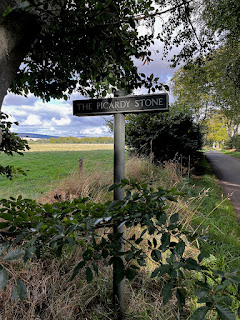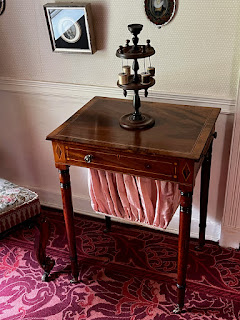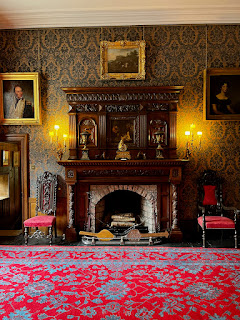Today was certainly a mixed adventure, as we began our day heading south to Haddo house after checking out of our B&B in Portsoy. We found ourself traveling along narrow country roads with a surprise or two along the way.


And, finally, we were entering the long drive to the house.
We immediately headed to the visitor center so that we could secure the 11:00 AM tour of the house. In the end, there were only 13 people, total, on the tour, which as far better than the 35 at Brodie Castle earlier in the week!
Our tour guide was Charlie, and she was an enthusiastic and informative guide who passed on a LOT of information. Once again, photos were not permitted of the inside rooms, but you can be guaranteed that the interior was brimming with fine art and unusual items.
The architect who designed the house was William Adam. If the name sounds familiar, it's because it's the same designer as yesterday's Duff house. This is one of Adam's earlier ventures, and Haddo house brought fame to his name, which led to future homeowners requesting his talents in designing for them.
It was interesting looking at Haddo House in comparison to Duff house, as the original plans of Duff included many of the features that Haddo encompassed, such as two side wings to house servants as well as a stable.
But what was extremely fascinating to me, was the inscription in the stone in the front:
Look carefully, and you will see: WILLIAM EARL OF ABERDEEN
MDCCXXXII ANNE GORDON COUNTESS OF ABERDEEN
Anne was the daughter of the 2nd Duke of Gordon. She was a young maiden when she married Lord Haddo, a widower in his fifties. Her father insisted that a new residence be built for his daughter upon marrying the Lord, and so, it appears that the house was built a few years into their marriage which had been in 1729. With the inscription on the front for all to see, there is no doubt.
Charlie gave the history of the family via portraits that continue to hang on the walls throughout the house. One of the more interesting stories involved a visit from Queen Victoria and Prince Albert. Victoria sent notice to Lord Haddo, the 4th earl of Aberdeen, that she would be visiting. He was prime minister at the time. He had new furniture built specifically for the Queen, which still stands in the house today.
She arrived with a welcoming gift: a plaster likeness of her head, which continues to stand on a pedestal in the front hall. It is said that she was not impressed with Haddo hall, and she stayed less than 24 hours prior to departure.
The room is decorated to the time period of the queen's visit. And the walls are filled with numerous sketches of Victoria over the years.
A generation later, the fifth earl granted his wife an exorbitant amount of money to upgrade the house to her standards in the late 1800's. She went through every penny, and then some. So, much of the house reflects the upgrades that she had made to it while she was living there.
She and her husband, John, were both philanthropists, and they gave most of their money away to various charities, making it very difficult for future generations to be able to upkeep the grandiose house. So, the house was gifted to the National Trust, although the estate continues to be owned by the family.
The house includes a lovely chapel attached to the side. You can see the stained glass windows from the back of the house.
The gardens around the back were stunning! So many beautiful flowers to enhance the grounds.
As you can see, much care has gone into maintaining the grounds to the highest standards.
These two information boards contain copies of the paintings of the 5th earl and his wife, Ishmel. You can't see the originals, but you can view their likeness here.
He became the Marquess of Aberdeen. His grandson, the 3rd Marquess of Aberdeen, inherited the property but had no children. During world War II, he opened the house as a maternity hospital for anyone in need. The only requirements were that the woman needed to be at least 7 months pregnant, and she was permitted to live in the house for just 3 months after the child was born.
1,250 babies were born at Haddo house during that time, and the 3rd Marquess gave each baby a silver six pence prior to leaving. He loved to spend time with each one of the babies after their birth.
To this day, any one of those children who were born in Haddo House, are admitted to take the tour at no cost, and they've had several make the trip to see the place of their birth.
Don't you just love a happy story?
From here we headed northeast to Fraserburgh, to visit the Scottish Lighthouse Museum.
What makes this so fascinating is that the lighthouse was added to the Kinnard Head Castle keep that originally stood at the point. When first constructed, it stood on the roof of the keep, but the roof began to show signs of stress. So Robert Stevenson designed a lighthouse tower that was constructed in the corner of the keep.
Very clever, don't you think?
These buildings were originally part of the castle grounds, but were coverted to housing for the families of the men who cared for the lighthouse.
Our tour involved a detailed explanation of the history, and we were taken inside to climb the steps to the top.
The views were pretty spectacular.
Here you see the replacement lighthouse, built in the late 1990's, that on a lighting system rather than oil lamps.
We got a close up look at the actual lens
and here's the view looking down.
Marty took that photo as I didn't dare look!
Near the coast stands the obsolete foghorn that would have been used in times of thick fog or snow. The pumps that powered the horn are stored in one of the outbuildings from the original keep.
The tour of the lighthouse was just one facet of the museum. There were rooms filled with just about everything you might want to know about lighthouses, with the focus on those in close proximity to Fraserburgh.
One could spend hours there absorbing all of that information. In fact, I'm pretty sure we did!
It was late afternoon by now, so we headed down the coastal route to our B&B in Cruden Bay. It's called Outlander Boutique B&B, but, to my knowledge, it has no connection to the series by the same name. It's just a small place, located on a quiet street in a tiny village. Perfect!
We took a little walk to explore the village before dinner.
And dinner was just next door at the pub. You just can't beat that for convenience!
Until tomorrow....




































































































